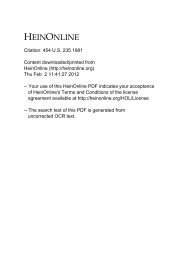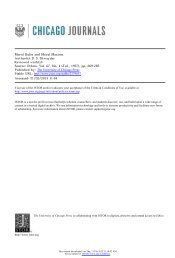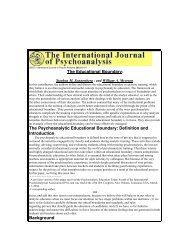Coagulation Factors in Controlling Traumatic Bleeds: FFP, PCC, or ...
Coagulation Factors in Controlling Traumatic Bleeds: FFP, PCC, or ...
Coagulation Factors in Controlling Traumatic Bleeds: FFP, PCC, or ...
You also want an ePaper? Increase the reach of your titles
YUMPU automatically turns print PDFs into web optimized ePapers that Google loves.
Statistics<br />
(cont<strong>in</strong>ued)<br />
Results<br />
Chi 2 test<strong>in</strong>g: effects on 48 hr m<strong>or</strong>tality<br />
Wilcoxon-Mann-Whitney rank test: (post-hoc) ventilat<strong>or</strong>-free and ICU-free days with<strong>in</strong> 30 days of trial product use<br />
Patient groups:<br />
143 patients eligible f<strong>or</strong> analysis <strong>in</strong> blunt trauma trial: 74 placebo + 69 rFVIIa<br />
124 patients eligible f<strong>or</strong> analysis <strong>in</strong> penetrat<strong>in</strong>g trauma trial: 64 placebo + 70 rFVIIa<br />
Treatment groups well-matched <strong>in</strong> both trauma populations<br />
Predom<strong>in</strong>antly male patients; characterized by be<strong>in</strong>g coagulopathic, acidotic, and hypothermic<br />
Causes of penetrat<strong>in</strong>g trauma primarily gunshots (68%) and stab wounds (30%); 77% of blunt trauma due to trafficrelated<br />
<strong>in</strong>jury<br />
Transfusion requirements:<br />
Blunt trauma patients: rFVIIa reduced 48-hr requirements by 2.6 units (p=0.02); need f<strong>or</strong> massive transfusion<br />
reduced from 33% of patients <strong>in</strong> placebo group to 14% of patients <strong>in</strong> the rFVIIa group (p=0.03)<br />
Penetrat<strong>in</strong>g trauma patients: no significant effect of rFVIIa <strong>in</strong> 48-hr RBC requirements; need f<strong>or</strong> massive transfusion<br />
reduced from 19% <strong>in</strong> the placebo group to 7% <strong>in</strong> the rFVIIa group (p=0.08)<br />
No statistical difference <strong>in</strong> patients who died to the w<strong>or</strong>st outcome<br />
No significant differences <strong>in</strong> adm<strong>in</strong>istration of fresh frozen plasma, platelets, n<strong>or</strong> cryoprecipitate<br />
Auth<strong>or</strong>s’<br />
Conclusions<br />
Take Home<br />
Po<strong>in</strong>ts<br />
Critique<br />
Cl<strong>in</strong>ical outcome and safety:<br />
Positive trends <strong>in</strong> fav<strong>or</strong> of rFVIIa f<strong>or</strong> death, critical complications (MOF and ARDS)<br />
Overall similar ADR profiles between groups <strong>in</strong> both trials<br />
12 thromboembolic ADRs rep<strong>or</strong>ted dur<strong>in</strong>g both trials: 6 <strong>in</strong> rFVIIa-treated patients, 6 <strong>in</strong> placebo-treated patients<br />
rFVIIa significantly improved bleed<strong>in</strong>g control, as reflected by the decrease <strong>in</strong> RBC transfusion requirements and the<br />
number of patients requir<strong>in</strong>g massive transfusion <strong>in</strong> a population of blunt trauma patients with severe bleed<strong>in</strong>g and<br />
coagulopathy secondary to the traumatic <strong>in</strong>jury<br />
rFVIIa appears to be a promis<strong>in</strong>g adjunct to exist<strong>in</strong>g therapy with<strong>in</strong> trauma<br />
In blunt trauma patients, rFVIIa reduced RBC requirements and need f<strong>or</strong> massive transfusion<br />
No difference between placebo and rFVIIa groups <strong>in</strong> m<strong>or</strong>tality<br />
Similar thromboembolism ADRs rep<strong>or</strong>ted between groups <strong>in</strong> both trials<br />
Power not met on RBC transfusion endpo<strong>in</strong>ts <strong>in</strong> penetrat<strong>in</strong>g trauma population; likely expla<strong>in</strong>ed by higher prop<strong>or</strong>tion<br />
of surgically treatable bleed<strong>in</strong>g<br />
Data on thromboembolic complications collected through adverse event rep<strong>or</strong>t<strong>in</strong>g only – likely underrep<strong>or</strong>t<strong>in</strong>g of<br />
asymptomatic thromboembolic events<br />
Differences <strong>in</strong> patient management across regions and trial centers due to complexity of study population and<br />
diversity of choices faced by trauma teams – despite adherence to trial protocol<br />
o Potential <strong>in</strong>fluence of site-specific effects on RBC reduction assessed by parametric analysis of the ranks<br />
<strong>in</strong>clud<strong>in</strong>g a site effect and a site-treatment <strong>in</strong>teraction – effect of treatment was <strong>in</strong>dependent of site (p=0.24) f<strong>or</strong><br />
the site vs. treatment <strong>in</strong>teraction<br />
Transfusion therapy not standardized care; confound<strong>in</strong>g variable, yet used as primary endpo<strong>in</strong>t<br />
o Placebo group acted as control across census<br />
Upper limit dosage used to assess safety<br />
Per auth<strong>or</strong>, total rFVIIa dose of 400 mcg/kg achieved FVII level of 40 mcg/L <strong>in</strong> the plasma<br />
o <strong>FFP</strong> and cryoprecipitate (unknown dose) approach ~1/3 of this, and contribute to dilutional coagulopathy<br />
XVX. Safety of rFVIIa <strong>in</strong> off-label trials 45<br />
a. Review of 26 studies <strong>in</strong>volv<strong>in</strong>g 4419 patients<br />
b. All rep<strong>or</strong>ted thrombotic <strong>or</strong> embolic were confirmed by means of objectives tests<br />
i. Arterial (c<strong>or</strong>onary, cerebrovascular, other) and venous<br />
c. Rate of thromboembolic events similar between groups (10.2% <strong>in</strong> rFVIIa vs. 8.7% <strong>in</strong> placebo, p=0.16)<br />
e. Higher arterial thromboembolic event rate <strong>in</strong> rFVIIa group vs. placebo group (5.5% vs. 3.2%, p=0.003)<br />
i. No significant difference <strong>in</strong> <strong>in</strong>cidence of venous thromboembolisms<br />
e. Three trauma studies, n=837 (<strong>in</strong>cluded Boffard et al.)<br />
i. 428 placebo + 409 rFVIIa (20% of total population assessed)<br />
ii. Mean age 36.5 years, all <strong>in</strong> rFVIIa group received > 120 mcg/kg<br />
iii. 4.6% <strong>in</strong>cidence arterial thrombosis vs. 3.5% <strong>in</strong> placebo group (p=0.36)<br />
iv. Boffard et al. trial makes up 32% (277/837); likely underrep<strong>or</strong>t<strong>in</strong>g of asymptomatic<br />
thromboembolic events<br />
R. Sohraby 13

















